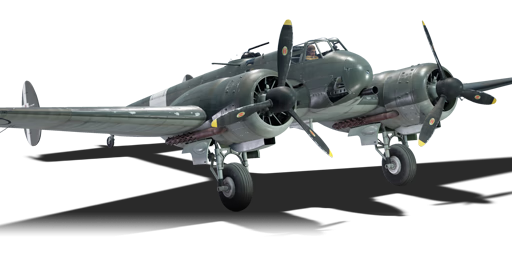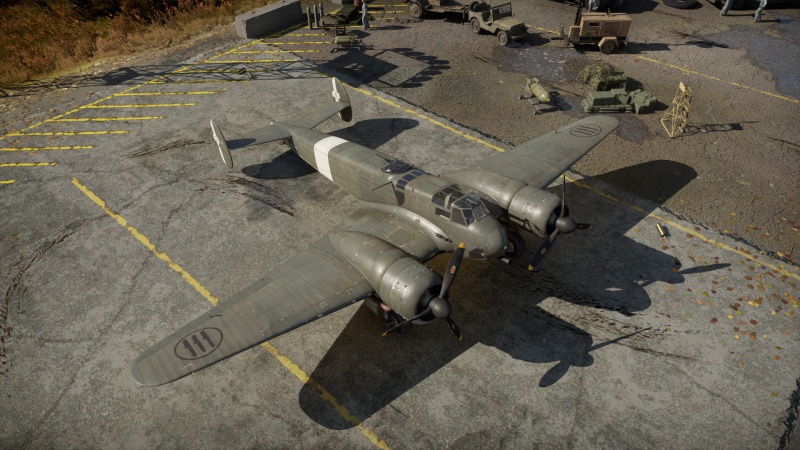Difference between revisions of "F.C.20 Bis"
Colok76286 (talk | contribs) (Edits) |
(I killed 3 planes with defensive armament. Definitely not underwhelming.) (Tag: Visual edit) |
||
| Line 159: | Line 159: | ||
** Has a quick-firing 37 mm (with APHE shells to destroy ground targets and HE shells to destroy aircraft) | ** Has a quick-firing 37 mm (with APHE shells to destroy ground targets and HE shells to destroy aircraft) | ||
** Payloads can serve a variety of different purposes | ** Payloads can serve a variety of different purposes | ||
| + | * Defensive armament has incendiary and armor-piercing belts | ||
* Defensive turret has a 180° turn radius, covering a wide range | * Defensive turret has a 180° turn radius, covering a wide range | ||
* Low battle rating allows it to face reserve-tier biplanes | * Low battle rating allows it to face reserve-tier biplanes | ||
| Line 168: | Line 169: | ||
* Weak engines | * Weak engines | ||
* Catches fire easily | * Catches fire easily | ||
| − | |||
* Loses a lot of speed in turns | * Loses a lot of speed in turns | ||
* Not very fast for its BR | * Not very fast for its BR | ||
Revision as of 03:24, 26 January 2022
Contents
Description
The F.C.20 Bis is a rank I Italian strike aircraft with a battle rating of 2.0 (AB/RB) and 2.3 (SB). It was introduced in Update "New Power".
General info
Flight performance
| Characteristics | Max Speed (km/h at 3,700 m) |
Max altitude (metres) |
Turn time (seconds) |
Rate of climb (metres/second) |
Take-off run (metres) | |||
|---|---|---|---|---|---|---|---|---|
| AB | RB | AB | RB | AB | RB | |||
| Stock | 425 | 410 | 7500 | 26.0 | 27.2 | 4.8 | 4.6 | 600 |
| Upgraded | 456 | 439 | 24.1 | 25.0 | 8.1 | 6.4 | ||
Details
| Features | ||||
|---|---|---|---|---|
| Combat flaps | Take-off flaps | Landing flaps | Air brakes | Arrestor gear |
| X | ✓ | ✓ | X | X |
| Limits | ||||||
|---|---|---|---|---|---|---|
| Wings (km/h) | Gear (km/h) | Flaps (km/h) | Max Static G | |||
| Combat | Take-off | Landing | + | - | ||
| 0 | 280 | N/A | 320 | 260 | ~9 | ~5 |
| Optimal velocities (km/h) | |||
|---|---|---|---|
| Ailerons | Rudder | Elevators | Radiator |
| < 280 | < 280 | < 410 | > 250 |
Survivability and armour
- 8 mm of steel in the nose in front of the pilot
- 8 mm of steel in the floor of the cockpit
- 8 mm of steel of the pilot seat
- 8 mm of steel in rear fuselage
- 38 mm bulletproof glass in front of pilot
- Self-sealing fuel tanks (2 in each wing)
Modifications and economy
Armaments
Offensive armament
The F.C.20 Bis is armed with:
- 1 x 37 mm Breda Model 39 37/54 cannon, nose-mounted (42 rpg)
- 2 x 12.7 mm Breda-SAFAT machine guns, wing-mounted (350 rpg = 700 total)
Suspended armament
The F.C.20 Bis can be outfitted with the following ordnance:
- Without load
- 2 x 50 kg GP 50 bombs (100 kg total)
- 2 x 100 kg GP 100T bombs (200 kg total)
- 2 x 100 kg SAP 100M bombs (200 kg total)
- 2 x 160 kg A.P 160 bombs (320 kg total)
Defensive armament
The F.C.20 Bis is defended by:
- 1 x 12.7 mm Scotti machine gun, turret (650 rpg)
Usage in battles
Air battles
The F.C.20 Bis is an attacker, very good at its BR. At the beginning of the battle, attack ground targets or climb to altitude and attack bombers, attackers and interceptors. Your 37 mm cannon is very powerful, even one shot can destroy a plane, in fact the 37 mm cannon can be used against ground targets with armour. If an enemy plane is approaching to attack you from behind, use your rear 12.7 mm Scotti machine gun with the universal belt that contains 2 AP-I bullets and 2 API-T bullets per belt.
Use the tracer ammunition belt that contains 4 API-T bullets per belt for the 12.7 mm Breda-SAFAT offensive machine gun. For the 37 mm Breda Model 39 37/54, use the air targets belt that contains 4 HEF-T bullets per belt against enemy aircraft, and the armored targets belt that contains 4 APHE bullets per belt against ground targets. The later belt is good because it has a post-penetration damage that increases the damage caused by these shots.
Ground battles
When using the F.C.20 Bis in mixed ground battles, use the following payloads: 2 x SAP 100M or 2 x AP 160. After spawning with the F.C.20 Bis, increase your altitude and dive to drop your bombs with greater accuracy. Set the fuse on the bombs to a minimum of 1 to 1.5 seconds.. After delivering your bombs, gain some altitude and perform dive attacks with the Breda Model 39 37/54 to shoot through the top of ground vehicles where you can easily penetrate them and cause damage or destroy them.
Naval battles
You can use the F.C.20Bis in land mode, use the following payloads: 2x SAP 100M or 2x AP 160. Set the fuse on the bombs to assault fuse, after you spawn with the F.C.20 Bis, increase your altitude and choose a naval target. After selecting it, fly in its direction until you're above, perform a vertical dive attack. While you are diving, evade the AA shots and after positioning yourself perpendicularly on the enemy ship, try to drop the bombs in the vital points of the ship (turrets, bridge, engine bay), then fly away, dodging anti-aircraft fire.
AB mode
In arcade mode, you can attack ground targets or you can dogfight with enemy planes with your manoeuvrability. Make sure that no one is behind you because if a fighter comes from behind you can not easily defend yourself.
Manual Engine Control
| MEC elements | ||||||
|---|---|---|---|---|---|---|
| Mixer | Pitch | Radiator | Supercharger | Turbocharger | ||
| Oil | Water | Type | ||||
| Controllable | Controllable Not auto controlled |
Controllable Not auto controlled |
Controllable Not auto controlled |
Separate | Not controllable 1 gear |
Not controllable |
Pros and cons
Pros:
- Good ground attack capabilities
- Has a quick-firing 37 mm (with APHE shells to destroy ground targets and HE shells to destroy aircraft)
- Payloads can serve a variety of different purposes
- Defensive armament has incendiary and armor-piercing belts
- Defensive turret has a 180° turn radius, covering a wide range
- Low battle rating allows it to face reserve-tier biplanes
Cons:
- Mediocre climb rate
- Heavy plane
- Weak engines
- Catches fire easily
- Loses a lot of speed in turns
- Not very fast for its BR
History
History
The multi-role attacker FIAT CANSA F.C.20 was developed by the Giacomo Mosso, an Italian aeronautic engineer, after the experience made with Ing. Rosatelli on the CR.25, he decided, in order to reduce design time, to adopt for the new aircraft the side wings, engines and undercarriage of the twin-engine FIAT.
Thus the F.C.20 (FIAT CANSA 20) was built and was proposed to the Regia Aeronautica in competition with the Caproni-Bargamasche Ca.331, AUT.45 of the Aeronautica Umbra, Ambrosini SAI.9 and IMAM Ro.61.
The Aeronautical Administration ordered two examples of Ca.331, AUT.45 (later cancelled) and F.C.20, the order was communicated to CANSA and on 15 October 1938 the two prototypes were assigned serial numbers MM 403 and MM 404.
The F.C.20 continued its evaluation cycle at Guidonia, without arousing any particular enthusiasm and probably would have been abandoned if, at the request of the new Chief of Staff General Fouger, the competition for an assault and ground attack aircraft had not been announced together with that for a twin-engine dive-bombing aircraft.
CANSA immediately saw the chance to save its aircraft and immediately undertook the transformation of the two prototypes.
New versions of the F.C.20 were thus born, one of which, the F.C.20Bis, was to be a a true remake of the original aircraft. The most noticeable renovations were in the fuselage, which underwent extensive structural and architectural modifications.
The crew area was protected by armoring the front fuselage, the rear turret, the floor and the pilot's seat. The crew was reduced to only two persons: pilot and gunner-radio operator.
The armament consisted of a Breda Model 39 37/54 gun from two 12.7 mm Breda-SAFAT machine guns fixed in the fighter with 350 shots each, and a 12.7 mm "Scotti" mounted in a Caproni Lanciani Delta E dorsal turret with 500 shots.
In addition to the 250 kg wing attachments, the installation of a "Nardi" ventral splitter with 2 kg anti-personnel bombs was also planned, but it does not appear that this was installed.
Other variants:
- F.C.20
- F.C.20Ter
- F.C.20Quater
Italian military service
Few production FC.20Bis were built and it is known that three served the 174th Strategic Reconnaissance Squadron in July 1943 but were not used operationally. Italian military operations ceased with the armistice of September 1943.
Media
- Skins
See also
- Aircraft of comparable role, configuration and era
External links
| Fiat Aviation (Fiat Aviazione) | |
|---|---|
| Fighters | CR.32 · CR.32 bis · CR.32 quater |
| CR.42 · Marcolin's C.R.42 CN · ▀Marcolin's C.R.42 CN | |
| G.50 serie 2 · G.50 AS serie 7 | |
| G.55 sottoserie 0 · G.55 serie 1 · G.55S | |
| G.56 | |
| Jet fighters | G.91 pre-serie · G.91 R/1 · G.91 Y · G.91 YS |
| ▄F-86K* | |
| ▄F-104G* · F-104S* · F-104S.ASA* · ▄F-104S TAF* | |
| Strike aircraft | F.C.20 Bis |
| Bombers | B.R.20DR · B.R.20M M1 |
| Export/Captured | J11 · ▀CR.42 |
| ▀G.50 serie 2 · ▀G.50 AS serie 7 | |
| ◄G.91 R/3 · ◄G.91 R/4 · G.91 R/4 | |
| *Licensed | |
| See also | North American Aviation · Lockheed Martin |
| Italy strike aircraft | |
|---|---|
| Ba.65 (K.14) L · Breda 88 (P.XI) · F.C.20 Bis · P.108A serie 2 | |
| Ro.57 Quadriarma · SM.91 · SM.92 | |
| Hungary | ◐Bf 110 G-4 · ◔IL-10 |
| Romania | Hs 129 B-2 (Romania) |





